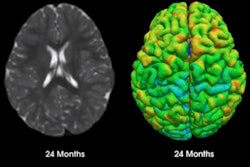Dear AuntMinnie Member,
A new study has been published investigating one of the biggest patient safety issues in radiology today: gadolinium retention in the brain following MRI contrast administration.
Previous studies have demonstrated that traces of gadolinium remain in the brain long after administration of gadolinium-based contrast agents (GBCAs). But a number of questions remain, particularly whether the retained contrast has any impact on health.
So far, no studies have found a link between retained gadolinium in the brain and any adverse health conditions (another gadolinium-related health issue, nephrogenic systemic fibrosis, has mostly been eliminated by avoiding GBCA use in patients with impaired kidney function).
Researchers from GE Healthcare, which makes the Omniscan gadolinium contrast agent, investigated levels of gadolinium retention in a group of rats that were given two commercially available contrast agents, with the primary goal of seeing how quickly gadolinium cleared from the animals' brains.
Find out what they discovered by clicking here, or visit our MRI Community at mri.auntminnie.com.
3 biggest threats to radiology
Meanwhile, a new article in our Imaging Leaders Community explores the three biggest threats to radiology, according to a team of authors that includes noted healthcare economics researcher Dr. Ezekiel Emanuel, PhD, of the University of Pennsylvania.
The authors observe that while radiology has historically been one of the most attractive medical specialties to aspiring physicians, major changes in healthcare are beginning to reverse this trend. These include falling demand for imaging as care moves from hospitals to the outpatient arena, the growth of payment reforms like capitation, and the rise of machine learning and artificial intelligence.
Of the three, machine learning is the most threatening, the authors believe, as they see computers beginning to do the work of radiologists -- and sooner rather than later. This position is contrary to the more sanguine predictions being made by radiologists, who believe that machine learning will either be a boon to radiologists or is decades from becoming viable in the clinical setting.
Read more about their predictions by clicking here for an article in our Imaging Leaders Community, and join the lively debate on the article in our Forums by clicking here.
While you're in the community, be sure to check out this story on how to prepare for changes in coding that are coming up in 2017 for studies in the Medicare and Medicaid systems.




















